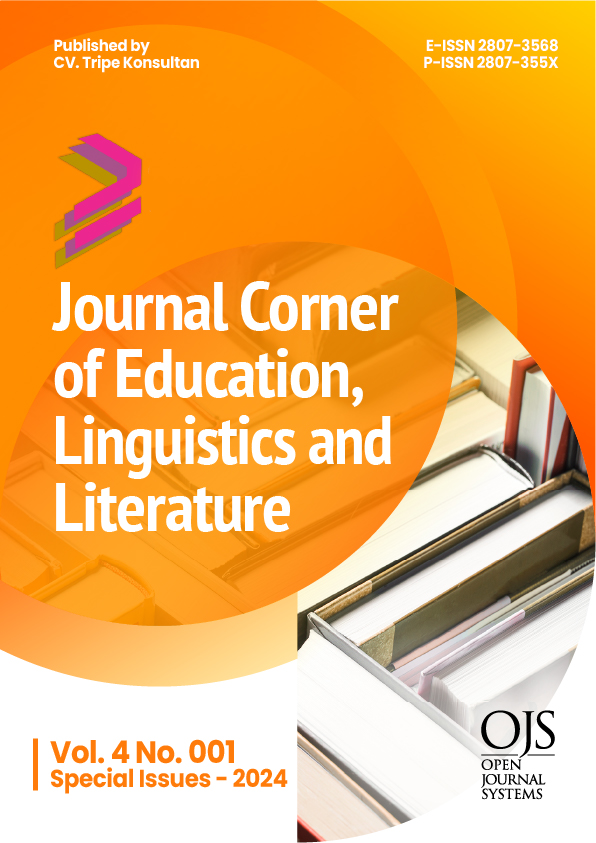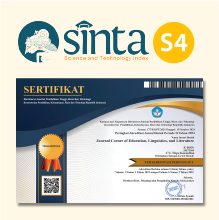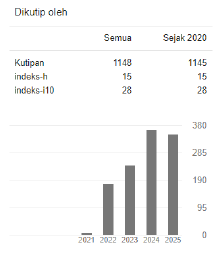Application of Think Pair Share Type Cooperative Learning Model to Improve Creative Thinking Ability
 https://doi.org/10.54012/jcell.v4i001.392
https://doi.org/10.54012/jcell.v4i001.392
 Abstract views: 213
Abstract views: 213
 PDF downloads: 151
PDF downloads: 151
Keywords:
Mathematics, Critical Thingking, Creative Thingking, Think Pair shareAbstract
This research aims to determine the effect of the Think pair share (TPS) cooperative learning model in improving the critical and creative thinking abilities of class VI C students at SD Negeri 1 Harapan Jaya. The classroom action research method used includes initial reflection, action plan, action, observation, evaluation, and final reflection. The results of the research were concluded as follows: (a) Students' critical thinking skills experienced an increase after the implementation of the Think Pair Share cooperative learning model by looking at the learning outcomes scores in the mathematical learning achievement. (b) Mathematics result scores of class VI C students at SD Negeri 1 Harapan Jaya experienced an increase after giving action. In the first cycle of students who had a score of 75-100, there were 21 students out of 30 students, while the second cycle of students had a score of 75-100 a total of 28 students out of 30 students. had success with a percentage of 93.33% and as many as 28 students. (c) Mathematics grade level of students in class VI C of SD Negeri 1 Harapan Jaya is increasing. Cycle I pada has completeness with a percentage of 70%, while cycle II has completeness with a percentage of 93.33%. (d) Students' ability to think creatively experiences an increase after the implementation of the Think Pair Share cooperative learning model by looking at the results of observations carried out during ongoing learning activities. In conclusion, the TPS learning model is effective in improving students' critical and creative thinking abilities. Therefore, teachers are recommended to adopt this method in teaching mathematics to achieve optimal results.
Downloads
References
Asmani, J. M. (2016). Tips Efektif Cooperative Learning: Pembelajaran Aktif, Kreatif, dan Tidak Membosankan. Diva Press.
Buan, Y. A. L. (2021). Guru dan Pendidikan Karakter : Sinergitas Peran Guru Dalam Menanamkan Nilai-Nilai Pendidikan Karakter di Era Milenial. Penerbit Adab. https://books.google.co.id/books?id=nOcREAAAQBAJ
Cottrell, S. (2023). Critical Thinking Skills: Effective Analysis, Argument and Reflection. Bloomsbury Publishing. https://books.google.co.id/books?id=rXy0EAAAQBAJ
Damayanti, F., & Yulistiana, M. (2021). Penerapan Model Pembelajaran Think Pair Share Terhadap Siswa Smk. Jurnal Online Tata Busana, 10(02), 75–83.
Daria, D. (2022). Jck Disharmonisasi Undang-Undang Nomor 20 Tahun 2003 Dengan Undang-Undang Nomor 12 Tahun 2012 Tentang Mata Kuliah Pancasila Sebagai Mata Kuliah Wajib Di Perguruan Tinggi. Jurnal Cahaya Keadilan, 10(1), 13–21.
Harjali. (2019). Penataan Lingkungan Belajar: Strategi untuk Guru dan Sekolah. Seribu Bintang. https://books.google.co.id/books?id=VNgNEAAAQBAJ
Kadi, T., & Awwaliyah, R. (2017). Inovasi pendidikan: Upaya penyelesaian problematika pendidikan di Indonesia. Jurnal Islam Nusantara, 1(2).
Kwok, A. P., & Lau, A. (2014). An exploratory study on using the think-pair-share cooperative learning strategy for students to solve mathematics problems in a hong kong primary school. Technology, Creativity and Affect in Mathematical Problem Solving, 300.
Maulana, M., & Irawati, R. (2017). Konsep Dasar Matematika dan Pengembangan Kemampuan Berpikir Kritis-Kreatif. UPI Sumedang Press. https://books.google.co.id/books?id=MBhKDwAAQBAJ
Muhamad Anugrah, S. P. I. S. S. M. P. (n.d.). Penelitian Tindakan Kelas: (Langkah-Langkah Praktis Pelaksanaan Penelitian Tindakan Kelas). Penerbit LeutikaPrio. https://books.google.co.id/books?id=9_6JDwAAQBAJ
Mulghalib, I. (n.d.). MODEL PEMBELAJARAN KOOPERATIF TIPE THINK-PAIR-SHARE. Alphiandi. https://books.google.co.id/books?id=xsuZEAAAQBAJ
Pianda, R. D. (2018). Strategi & Implementasi Pembelajaran Matematika di Depan Kelas. CV Jejak (Jejak Publisher). https://books.google.co.id/books?id=YCeLDwAAQBAJ
Prof. DR. H. Wina Sanjaya, M. P. (2016). Penelitian Tindakan Kelas. Prenada Media. https://books.google.co.id/books?id=YMtADwAAQBAJ
Qomariyah, D. N., & Subekti, H. (2021). Analisis kemampuan berpikir kreatif. Pensa: E-Jurnal Pendidikan Sains, 9(2), 242–246.
Rosmala, A. (2021). Model-Model Pembelajaran Matematika. Bumi Aksara. https://books.google.co.id/books?id=5xwmEAAAQBAJ
Rukajat, A. (2019). Pembelajaran contextual teaching and learning untuk meningkatkan mutu hasil pembelajaran. Pionir: Jurnal Pendidikan, 8(1).
Sitepu, A. S. M. B. (2019). Pengembangan kreativitas siswa. Guepedia.
Tanjung, D. S., Pinem, I., Mailani, E., Ambarwati, N. F., Sepriano, S., Efitra, E., & Sari, I. K. (2024). Penelitian Tindakan Kelas. PT. Sonpedia Publishing Indonesia. https://books.google.co.id/books?id=vGEOEQAAQBAJ
Downloads
Published
How to Cite
Issue
Section
License
Copyright (c) 2024 Meyronita Firja MKS

This work is licensed under a Creative Commons Attribution-ShareAlike 4.0 International License.
All articles published in the Journal Corner of Education, Linguistics, and Literature are licensed under the Creative Commons Attribution-ShareAlike License (CC BY-SA).

















